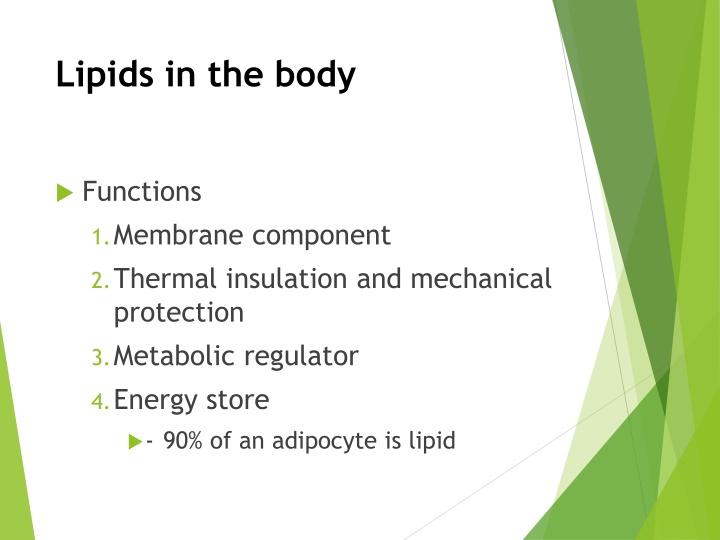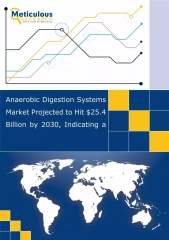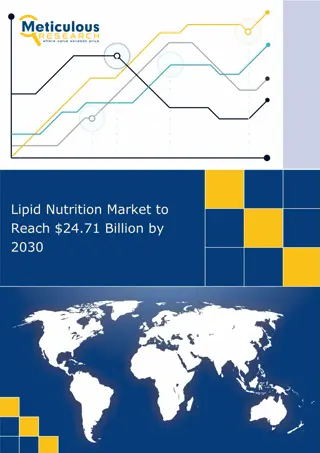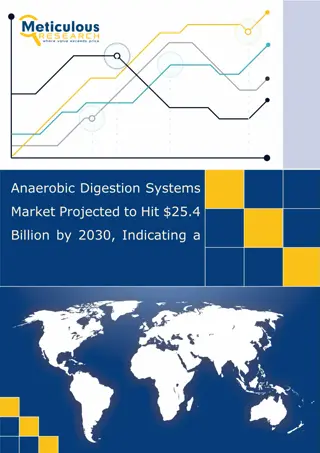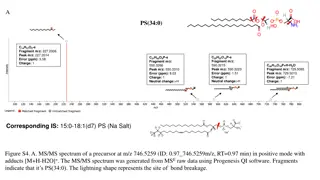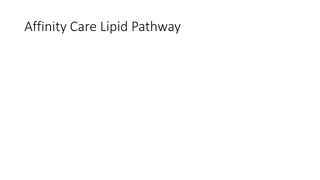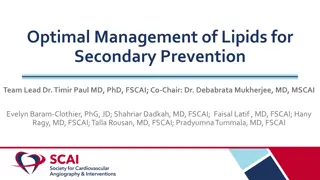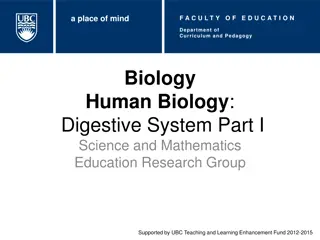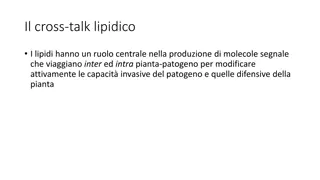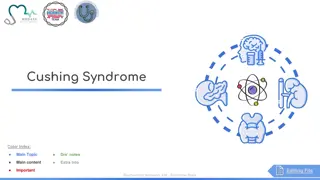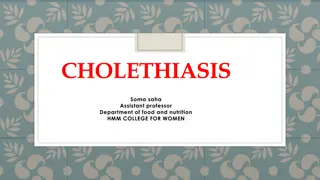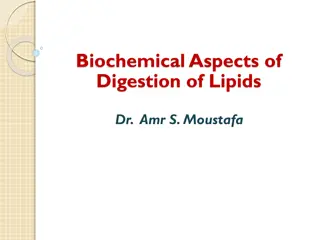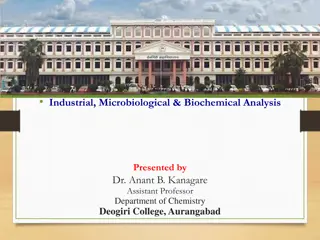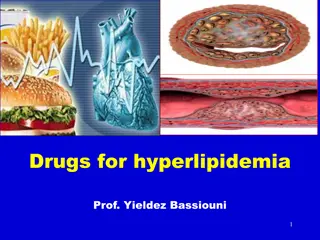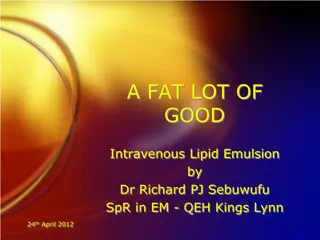Biochemical Aspects of Lipid Digestion Overview
This lecture covers the digestion of dietary lipids including organs, enzymes involved, degradation process by pancreatic enzymes, control mechanisms, absorption, and clinical manifestations related to lipid digestion disorders.
Download Presentation

Please find below an Image/Link to download the presentation.
The content on the website is provided AS IS for your information and personal use only. It may not be sold, licensed, or shared on other websites without obtaining consent from the author.If you encounter any issues during the download, it is possible that the publisher has removed the file from their server.
You are allowed to download the files provided on this website for personal or commercial use, subject to the condition that they are used lawfully. All files are the property of their respective owners.
The content on the website is provided AS IS for your information and personal use only. It may not be sold, licensed, or shared on other websites without obtaining consent from the author.
E N D
Presentation Transcript
Lipids in the body Functions 1.Membrane component 2.Thermal insulation and mechanical protection 3.Metabolic regulator 4.Energy store - 90% of an adipocyte is lipid
Types of Lipids https://upload.wikimedia.org/wikipedia/commons/thumb/5/5c/Common_lipids.png/1024px-Common_lipids.png
Types of Lipids https://upload.wikimedia.org/wikiped ia/commons/thumb/b/b5/Sphingolipid s_general_structures.png/1920px- Sphingolipids_general_structures.png
In 70 kg man 10 kg fat 93,000 Kcal glycogen 500-800 Kcal protein ~ 18,000 Kcal
Adipose tissue is located: In the abdominal cavity around kidneys and between the mesentery Beneath the skin Between skeletal muscle fibers
Lipid Digestion and Absorption
Lipid Digestion and Absorption Triglycerides Stomach Little digestion Gastric lipase is secreted in the stomach that hydrolyze long chain triglycerides Small intestine Fat digestion and absorption occurs primarily in the duodenum and jejunum
Lipid Digestion Large Lipid Droplet Action of bile salts (cholate, chenodeoxycholate) Lipid emulsion Small Bile salts activate pancreatic lipase and colipase Bile salts reabsorbed, transported back to liver Water soluble micelles
A. Luminal Phase Food entering small intestine causes the secretion of hormones such as cholecystokinin, pancreozymin and secretin Hormones cause gallbladder to contract and secrete bile Stimulate the pancreas to secrete pancreatic lipase
1. Emulsification Bile salts in combination with the churning action of the intestine emulsifies the fat breaking it down into small droplets This increases the surface area of triglycerides by a factor of ~10,000 Bile salts pH of intestine which causes secretion of pancreatic lipase
2. Partial Hydrolysis Pancreatic lipase Attacks the glycerol-FA ester bonds of triglycerides at positions 1 & 3 resulting in the release of 2-monoglyceride and 2 fatty acids Phospholipase A1 and A2 Hydrolyzes fatty acids from phospholipids Cholesterol esterase Hydrolyzes fatty acids from cholesterol esters
Triglyceride 2-monoglyceride + 2 FA + pancreatic lipase O R1 H2 C O C R1 O R1 H2 C O C R2 O H2 C O C R3 R3 R3
3. Mixed micelle formation Consist mainly of long chain FAs, monoglycerides and bile acids Short (2-6C) and medium chain FAs (6-12 C) are soluble enough in H2O that they can be absorbed into the portal blood
Long chain FAs and monoglycerides Micelles diffuse to the surface (brush border) of mucosal cells where they are broken down Long chain FAs and monoglycerides are absorbed into the intestinal mucosa by passive diffusion Bile salts remain in the lumen and move down the intestine where most are actively absorbed from the ileum
C. Intracellular Phase Short and medium chain FAs (12 C or <) enter portal blood and bind to albumin without being esterified Long chain FAs and monoglycerides are resynthesized into triglycerides in the endoplasmic reticulum of the mucosa
Triglyceride Synthesis 1. Monoglyceride (~85%) 2. Glycerol 3-phosphate (~15%)
Monoglyceride Pathway Occurs in the smooth endoplasmic reticulum Acyl - CoA Synthetase Fatty acid + ATP + CoA Fatty Acy-CoA + AMP + Pi Acyl-CoA synthetase is specific for fatty acids with greater than 12 carbons Monoglyceride + Fatty Acyl CoA Triglyceride Diglyceride Diglyceride + Fatty Acyl CoA
Glycerol 3-Phosphate Pathway Occurs in the rough endoplasmic reticulum Inhibited by monoglycerides Glycerol Glycerol 3-P fatty acyl CoA Phosphatidic Acid Fatty Acyl CoA Pi Phospholipid Diglyceride Triglyceride
FA content of the triglycerides synthesized in the intestinal mucosa is similar but not identical to that in the diet. http://homepage.smc.edu/wissmann_paul/anatomy2textbook/chylomicronpic.jpg
Generally fat is well absorbed 90% + Long chain saturated FA are not absorbed as rapidly as short chain or unsaturated FA A higher bile acid concentration is needed for micelle formation with long chain saturated FA Lack of bile decreases fat absorption
II. Phospholipid Secreted in the bile and some in diet Phospholipid Lysolecithin + FA Phospholipases Pancreatic Phospholipid must be dispersed into small micelles for enzymatic hydrolysis
Lysolecithin and FA produced become part of the mixed micelles They are absorbed and then resynthesized into phospholipids in the mucosal cells by the glycerol 3-PO4 pathway Phospholipids are then utilized to form the chylomicrons or VLDL
III. Cholesterol Human diet 400-700 mg/d combination of free and esterified Bile secretion 750-1250 mg/d free cholesterol Cholesterol esterase Cholesterol esters cholesterol + FA
Free cholesterol must be solubilized (mixed micelles) prior to absorption More cholesterol is taken up by micelles when micelles are enlarged due to the presence of high fat Cholesterol is taken up by the intestinal mucosa by passive diffusion then reesterified and incorporated in chylomicrons and VLDL
Lipid Transport Lipids appear in the blood in 3 forms 1. Lipoproteins 2. Free fatty acids mostly bound to albumin 3. Ketone bodies
I.Lipoproteins Transport form of lipid (TG, phospholipid, cholesterol) in blood Micromolecules of lipid and protein Differ in terms of: 1.Density 2.Amount of TG 3.Phospholipid 4.Cholesterol 5.Type & amount of protein
FA Lipoprotein Lipase VLDL IDL Intermediate density lipoproteins LDL Cholesterol esters Excess PL and cholesterol HDL cholesterol
A. Chylomicrons TG are primarily transported in chylomicrons and VLDL because TG are not soluble in H2O Chylomicrons are produced only in the small intestine and they contain TG of dietary origin
Digestion and absorption of lipid and the formation and secretion of chylomicrons into the blood takes several hours Turnover of chylomicrons are very rapid once they enter the blood (t 4-5 min) Lipoprotein lipase Triglyceride fatty acids + glycerol clearing factor lipase
Lipoprotein lipase is found on the outer surface of the endothelial cells lining the capillaries (adipose, heart, skeletal muscle,lung, mammary gland) In liver lipoprotein lipase is attached to the outer surface of the hepatocytes Following hydrolysis of TG the FAs diffuse into the tissue or they could remain in the blood and be transported to another tissue
Glycerol is transported in the blood to liver or kidney Glycerol kinase Glycerol + ATP Glycerol 3-P + ADP Oxidized Fatty Acids Esterified TG
FA Lipoprotein Lipase Chylomicron Chylomicron remnant Liver (Cholesterol ester & protein) PL Free cholesterol HDL Cholesterol esters from chylomicron remnants are secreted into the bile or used in synthesis of VLDL
The intestine secretes chylomicron particles into the lymphatics. They gain entrance into the general circulation through the thoracic duct. Lipoprotein lipase, on the luminal surface of adipose and muscle capillary endothelial cells, hydrolyzes the triglyceride core to free fatty acids and glycerol. The free fatty acids are re-esterified and stored as triglycerides in adipose tissue or undergo b-oxidation in muscle. The lipid-depleted chylomicrons, chylomicron remnants, are cleared by the liver through a pathway that depends on apolipoprotein-E as a ligand for cellular receptors
B. Very low density lipoproteins (VLDL) Lipoprotein that contains TG secreted from the liver TG in liver are synthesized from either acetyl CoA or FAs derived from blood or chylomicrons
When dietary cholesterol from chylomicron remnants is not available in adequate amounts for synthesis of VLDL, the liver synthesizes cholesterol Liver does this by increasing the activity of 3-hydroxy-3-methyl glutaryl coenzyme A reductase (HMG CoA reductase)
LCAT Lecithin cholesterol acyltransferase LCAT esterifies excess cholesterol in HDL with FAs derived from the 2- position of lecithin (PL) Half life of VLDL 1-3 hours
Lipoprotein lipase Activity determines which tissues take up FA Fed state high in adipose Fasted state-low in adipose, high in other tissues Insulin and glucose lipoprotein lipase in adipose and also formation of glycerol-P which stimulates esterification of FAs Parturition - LPL in mammary gland
Nutritional State Lipoprotein Lipase Activity Adipose Heart Skeletal M Fasted 3.3 19.0 15.4 CHO fed 14.8 9.7 8.5 Fat fed 7.9 15.1 14.4 J. Nutr. 105:447, 1975
C. Low Density Lipoproteins (LDL) Involved in cholesterol transport LDL is taken up by tissues metabolized and the cholesterol is released and used for cellular functions Specific receptor on the surface of the cell that binds LDL Most tissues except liver depend on LDL for their cholesterol supply
D. High density Lipoproteins (HDL) Functions in cholesterol and phospholipid exchange and cholesterol esterification reactions in plasma Accepts cholesterol from tissues
Cholesterol bound to HDL can be esterified in plasma by LCAT and transferred to VLDL and IDL to form LDL HDLs are synthesized in liver and small intestine Half life of 5-6 days
Lipid Transport Lipids appear in the blood in 3 forms 1. Lipoproteins 2. Free fatty acids mostly bound to albumin 3. Ketone bodies
II. Free Fatty Acids Some from intestinal absorption Most FFA arise from TG breakdown in adipose tissue
III. Ketone Bodies Synthesis Gut epithelium (esp. ruminants) Liver Uses (requires thioporase) Heart Brain Muscle
